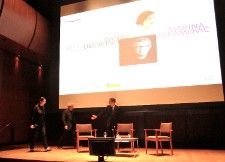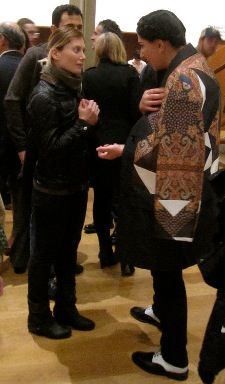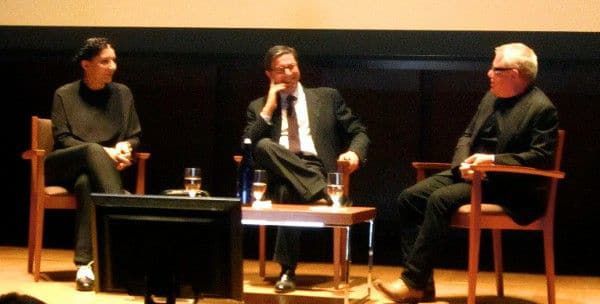The 2013 Le Conversazioni literary festival celebrating the relationship between art, architecture, literature, and film began at the Morgan Library & Museum on Thursday, May 9 in New York. Artistic Director of Le Conversazioni, Antonio Monda, discussed with performance artist Marina Abramovic and architect Daniel Libeskind films that influenced their lives and work. Nine clips from the chosen movies, four each, plus one from the moderator at the end, accompanied the sold-out event.
From Abramovic we learn how Willem Dafoe swam his way to become an Antichrist (because he couldn't walk on water this time), how Apocalypse Now can be a holy choice, and how Alain Robbe-Grillet's words lead you down the right corridors. Daniel Libeskind, on the other hand, explains how even without a word of English, Cary Grant, Frank Lloyd Wright and Hitchcock can explain all that's powerful in America.
The Films of My Life chosen by architect Libeskind were Georges Franju's Eyes Without A Face (1960), Paolo Sorrentino's The Consequences Of Love (2004), Hitchcock's North by Northwest (1959), and the 2011 This is Not a Film, directed by Jafar Panahi and Mojtaba Mirtahmasb.

Abramovic picked two films from 1968, Sergei Parajanov's The Colour Of Pomegranates and Pier Paolo Pasolini's Teorema, Last Year In Marienbad from 1961 directed by Alain Resnais, and Lars vonTrier's Breaking The Waves (1996).
Here are some of the insights they offered about their choices.
The Colour of Pomegranates
Abramovic says she "feels genetically connected to it" and brought up her grandfather.
Monda mentions that the director was in a labour camp because of his sexuality. Antonioni and others appealed to get him out of jail. "Andrei Tarkovsky wrote a letter saying: he is not guilty of anything but solitude. We are guilty."
The Consequences Of Love
Libeskind connects the corruption "between the bluff in crime with art itself" and says "the film has such an elegant morality". In the film, the mafia uses the concrete and, being an architect, Libeskind has a special relation to concrete buildings and what they might hide. "This film takes place mostly in the lobby of a hotel." Libeskind likes Sorrentino's "unique camera movements, something original". Abramovic comments on the beautiful locations of so many Italian films and "this one is really ugly". Aesthetics are not always the point.
Teorema
Pier Paolo Pasolini's film for Abramovic also deals with questions of morality, "it's about doing good". After the stranger, played by Terence Stamp, makes love to the maid (after he made love to the entire family) "she becomes holy, she starts levitating to the top of the church". Libeskind commented that the actress who plays the maid (Laura Betti) reminds him of Marina. The difference between the first two films she chose are of "a blasphemous and an orthodox catholic film".
Eyes Without A Face
Monda warns the audience about the graphic nature of the scene, the surgical removal of a face. "It seems to be this thriller but it is about something else." For Libeskind, the film is about Europe after the Second World War. "The same eyes are looking but the face has been changed." The second half of the 20th century is looking at what happened in the 30s and 40s. It is also about plastic surgery people can undergo, "but the eye hasn't changed, through all the catastrophes it is the same eyes." Abramovic says, she "completely understands" why he chose that film after his explanation. Without his words, the clip does nothing for her.
Monda is reminded of an anecdote from the Eyes Without a Face premiere at the Edinburgh International Film Festival where an audience member fainted. "Somebody said, 'Now I understand why Scotsmen wear kilts'."
In the middle of the programme, the participants are asked to name "a film that everybody loves and you can't stand".
Libeskind picks "what was hailed as the greatest breakthrough in modern cinema by US critic Pauline Kael. The [1972] Last Tango In Paris by [Bernardo] Bertolucci. I can't stand the fake love story… and so many critics said this will be the new direction for cinema".
Abramovic picks "just one - [Victor Fleming's 1939] Gone With The Wind." She gives no further explanation. "If I can cry, it's a good movie." Instead, she tells the audience the story of a holy man who visited her in Amsterdam. They go to a store to rent a movie, she hides him from the shelves with pornography. He says, "I want to see Apocalypse Now (Francis Ford Coppola, 1979)."
Libeskind likes the way Andre Breton and his surrealist friends went to see the last few minutes of movies. He thinks this is a great way to make a judgement.
Breaking The Waves

Abramovic calls Lars von Trier "one of the most disturbing filmmakers of all times" and Breaking The Waves "the ultimate movie about sacrifice - she thinks that if she will get sick, he will get better." What is important to Abramovic is "how to capture the human spirit - if you can't do that then the work is empty".
Libeskind comments: 'If you like something, then it's bad for you, because you could have written it yourself. If you don't like it, it is for you." Abramovic suggests to see von Trier's Melancholia in the afternoon while it is still light out. "The moon keeps looking bigger and bigger." She tells the story of Dafoe going to meet von Trier in Copenhagen in January, "where it's cold and dark." They had dinner and Lars suggested, "Shall we have a swim?" He knew he wouldn't get the role if he said no. The film was his 2009 Antichrist, and they went for the icy dip.
This is Not a Film
Jafar Panahi, sentenced to house arrest and under a 20-year ban for making films, smuggled the work out of Iran in a cake. "Freedom, liberty and art" are at stake, says Libeskind about his choice. "Nothing really happens in it - it's all implied… You get a sense of the depth of culture in Iran and at the same time - what happens if you're sentenced to jail and you still are an artist?" "I don't take it for granted to live in a country where we are allowed to say what we want. It's not a documentary - it's a film." Monda explains that Panahi used to be Abbas Kiarostami's assistant and adds some more background. Libeskind sums up the impact of the work: "Aesthetics are not important - it speaks to something much deeper".
Last Year In Marienbad
For Abramovic Alain Resnais' film hinges on the text by Alain Robbe-Grillet. We hear and we see. "The camera approaches different groups of people and then when the camera reaches the end of the corridor we hear laughter, laughter, laughter." In Providence, Resnais announced action. The park in Marienbad is all symmetry "and you get totally lost".
North by Northwest
"To me this is a very personal film, because when I came to America I spoke no English. It was my introduction to America," says Libeskind about the Hitchcock classic. "Cary Grant and James Mason, two equally gorgeous men. All the symbols of power - trains, airplanes, the CIA, the smuggling, the art sale." For the future architect, the fantastic house at the end left an impression, of course: "He wanted Frank Lloyd Wright's house (the one in the film is not an original) - there are no right angles in the house , which I love. He used Frank Lloyd Wright to show oblique angles."
Monda usually picks an Italian film to end the presentation but as both participants picked Italian films, he chose an American one, Sam Peckinpah's 1973 Pat Garret And Billy The Kid. He mentioned Godard's comments on the ending of The Searchers by John Ford and calls the Peckinpah ending its equal, the kid, who throws a stone at the man who killed his hero.






















